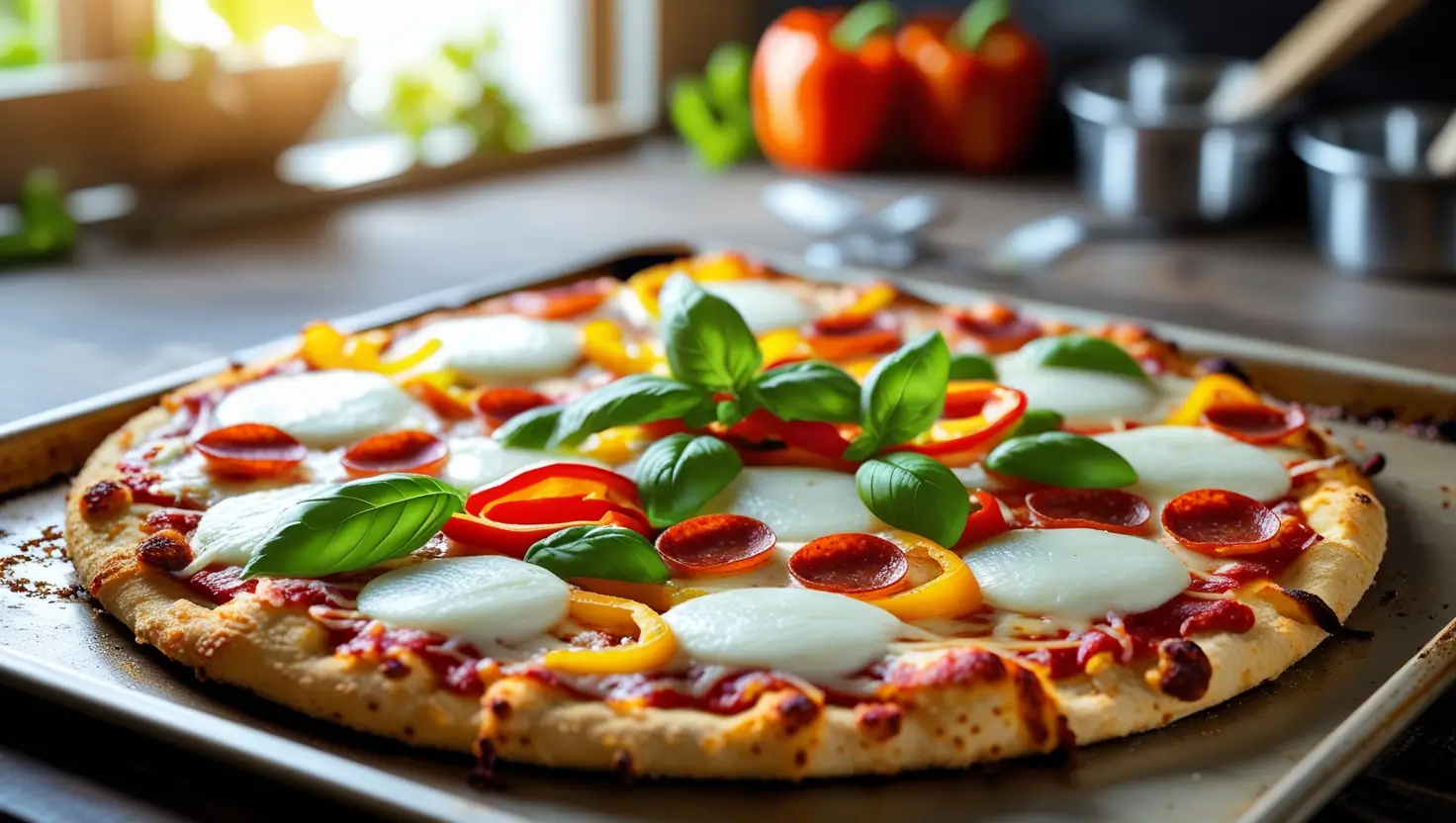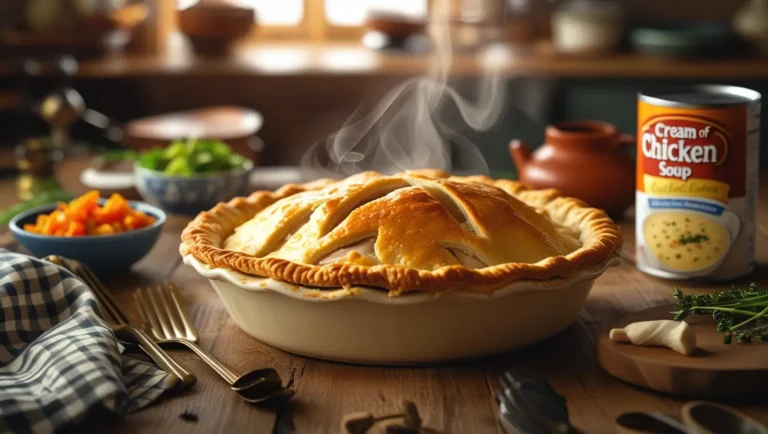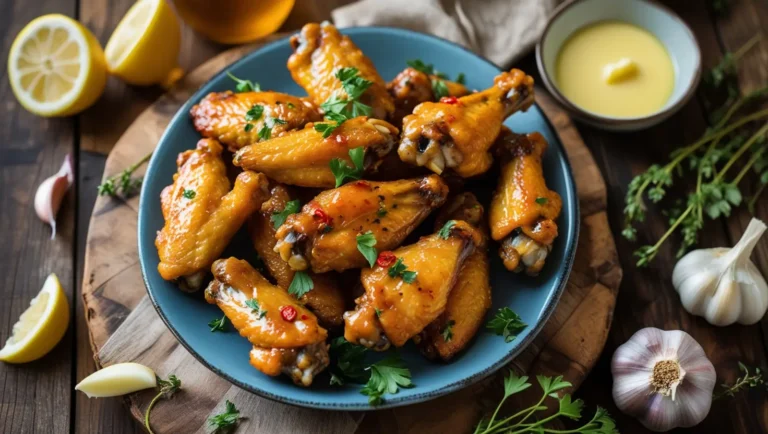Table of Contents
Missing pizza night while eating low carb or gluten-free? You’re not alone. I used to feel like I had to give up my favorite comfort food when I started prioritizing my health and watching my carb intake. The disappointment of skipping pizza nights with friends or settling for sad, cardboard-like alternatives left me craving something better. That’s when I discovered the game-changing world of chicken crust pizza.
This incredible alternative doesn’t just satisfy your pizza cravings – it actually makes you feel good about what you’re eating. With a surprisingly crispy texture and all the flavors you love, chicken crust pizza recipe has become my go-to solution for healthy comfort food. Whether you’re following a keto lifestyle, dealing with gluten sensitivity, or simply looking for a protein-packed dinner option, this recipe will revolutionize your meal planning.
In this comprehensive guide, you’ll discover everything you need to know about creating the perfect chicken crust pizza. From selecting the right ingredients and mastering the cooking technique to avoiding common pitfalls and exploring creative topping combinations, I’ll walk you through every step. You’ll also learn professional tips for achieving that coveted crispy texture, nutritional benefits that make this a guilt-free indulgence, and exciting variations to keep your taste buds interested.
What is Chicken Crust Pizza?
Chicken crust pizza represents a brilliant culinary innovation that transforms ground chicken into a firm, flavorful pizza base. Unlike traditional wheat-based crusts, this protein-rich alternative uses ground chicken as the primary ingredient, combined with cheese and egg to create a cohesive, bakeable foundation for your favorite toppings.
The concept might sound unusual at first, but the results are genuinely impressive. When properly prepared, chicken crust develops a golden-brown exterior with a satisfying texture that holds up beautifully under the weight of sauce, cheese, and toppings. The flavor is mild enough to complement any pizza combination while adding a subtle savory depth that traditional crusts simply can’t match.
Why It’s Gaining Popularity
The surge in chicken crust pizza popularity stems from several compelling factors that align perfectly with modern dietary preferences and health consciousness. First and foremost, it’s incredibly low in carbohydrates while being exceptionally high in protein. A typical slice contains less than 2 grams of carbs compared to 20-30 grams in regular pizza crust, making it an ideal choice for anyone monitoring their carbohydrate intake.
The keto and gluten-free friendly nature of chicken crust pizza has made it a staple in specialized diet communities. People following ketogenic lifestyles can enjoy pizza without breaking their macronutrient goals, while those with celiac disease or gluten sensitivity can indulge without fear of adverse reactions. The high protein content also promotes satiety, meaning you’ll feel fuller longer and may naturally eat smaller portions.
Perhaps most surprisingly, chicken crust pizza is genuinely delicious. The crispy exterior and tender interior create a texture that rivals traditional pizza crusts, while the savory chicken flavor enhances rather than competes with your chosen toppings. Many people who try it are amazed that such a healthy alternative can taste so satisfying.
Who It’s Perfect For
Chicken crust pizza serves a diverse audience of health-conscious food lovers. People following ketogenic or low-carb diets find it an essential tool for maintaining their lifestyle without feeling deprived. The macronutrient profile perfectly aligns with keto requirements, providing high fat and protein while keeping carbs minimal.
Individuals with gluten intolerance or celiac disease can finally enjoy pizza night without worry. The complete absence of wheat, barley, rye, and other gluten-containing ingredients makes this a safe and delicious option for those who must avoid gluten for health reasons.
Athletes and fitness enthusiasts appreciate the high protein content, which supports muscle recovery and growth. The lean protein from chicken provides essential amino acids while keeping calories reasonable, making it an excellent post-workout meal option.
Families looking to improve their eating habits without sacrificing beloved comfort foods find chicken crust pizza to be a perfect compromise. Kids often enjoy the novelty and taste, while parents feel good about serving a nutritious meal that everyone will eat happily.
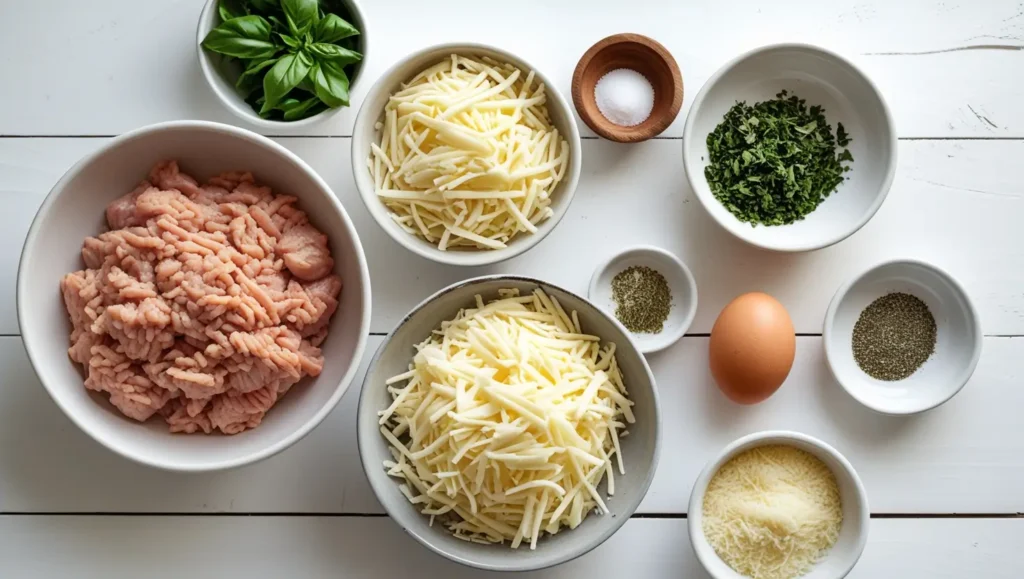
Ingredients You’ll Need
Creating the perfect chicken crust pizza requires just a handful of simple, wholesome ingredients that you can easily find at any grocery store. The beauty of this recipe lies in its simplicity – each ingredient serves a specific purpose in creating the ideal texture and flavor profile.
| Ingredient | Amount | Notes |
|---|---|---|
| Ground chicken | 1 lb | Preferably lean (93/7 or 85/15 ratio) |
| Shredded mozzarella | ½ cup | For crust binding and flavor |
| Parmesan cheese | ¼ cup | Adds crispness and umami depth |
| Egg | 1 large | Essential binding agent |
| Garlic powder | ½ tsp | Optional but recommended for flavor |
| Italian seasoning | 1 tsp | Creates authentic pizza taste |
| Salt | ½ tsp | Enhances all flavors |
| Black pepper | ¼ tsp | Adds subtle warmth |
The quality of your ground chicken significantly impacts the final result. Look for ground chicken with a moderate fat content – too lean and your crust may be dry, while too fatty can result in a greasy texture. The 85/15 ratio typically provides the best balance of flavor and texture.
Fresh herbs can be substituted for dried Italian seasoning if you prefer. Fresh basil, oregano, and thyme work beautifully, though you’ll want to use about three times the amount specified for dried herbs. The cheese combination of mozzarella and Parmesan isn’t just for flavor – mozzarella provides stretchy binding properties while Parmesan contributes to the crispy exterior.
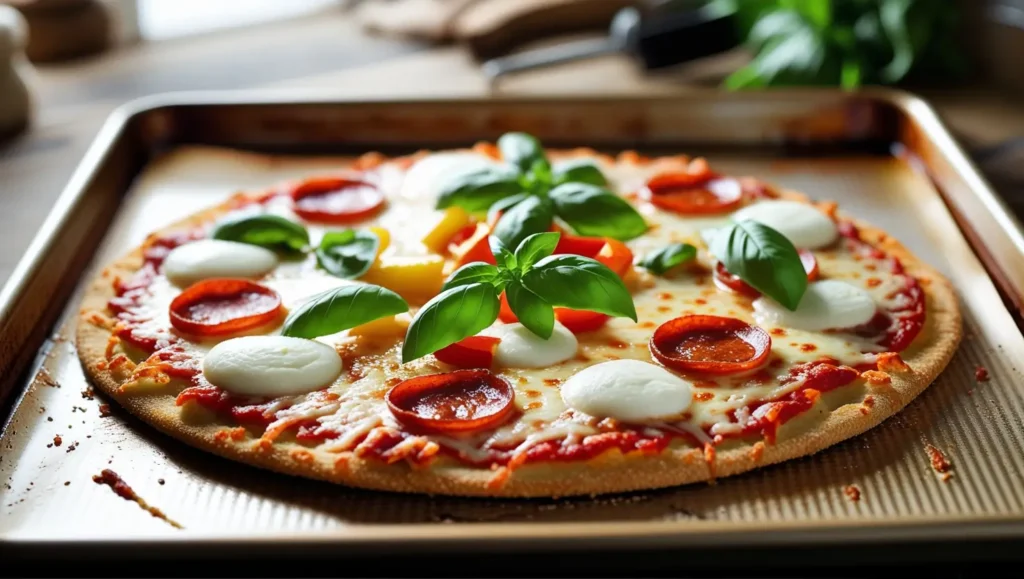
Step-by-Step Guide to Making Chicken Crust Pizza
Creating the perfect chicken crust pizza requires attention to detail and proper technique. Follow these steps carefully for consistently excellent results every time you make this healthy pizza alternative.
Prepping the Chicken Crust
Begin by preheating your oven to 425°F (220°C). This higher temperature is crucial for developing the crispy exterior that makes chicken crust pizza so appealing. Line a large baking sheet or pizza stone with parchment paper, ensuring the paper extends slightly beyond the edges for easy removal later.
In a large mixing bowl, combine the ground chicken with both cheeses, breaking up any large clumps with your hands or a fork. The chicken should be at room temperature for easier mixing, so remove it from the refrigerator about 15 minutes before you plan to start cooking. Add the egg, garlic powder, Italian seasoning, salt, and pepper to the bowl.
Mix all ingredients thoroughly using your hands or a large spoon until the mixture is well combined and holds together when pressed. The consistency should be similar to meatloaf mixture – cohesive but not overly dense. If the mixture seems too wet, add a tablespoon of grated Parmesan cheese. If it’s too dry, crack in an additional egg yolk.
Transfer the chicken mixture to your prepared baking sheet and shape it into a round pizza crust approximately 12 inches in diameter. The crust should be about ¼ to ⅜ inch thick – thin enough to crisp up nicely but thick enough to support toppings. Use wet hands to smooth the surface and create slightly raised edges to contain your toppings.
Bake the crust for 20-25 minutes, until it’s golden brown and firm to the touch. The surface should feel set and spring back slightly when pressed gently. This pre-baking step is essential for preventing a soggy final product.
Adding Toppings & Finishing the Pizza
Remove the crust from the oven and let it cool for 5 minutes. This brief cooling period prevents the toppings from sinking into the crust and helps maintain the crispy texture you’ve worked to achieve.
Spread your chosen pizza sauce evenly across the surface, leaving about a ½-inch border around the edges. Don’t overload with sauce – too much moisture can make the crust soggy. About ⅓ cup of sauce is typically perfect for a 12-inch crust.
Sprinkle shredded mozzarella cheese evenly over the sauce, using approximately 1 to 1½ cups depending on your preference. Add any desired toppings at this point, keeping in mind that less is often more with chicken crust pizza. The crust can support a reasonable amount of toppings, but overloading can compromise the texture.
Return the pizza to the oven for an additional 8-12 minutes, until the cheese is melted and bubbly and any meat toppings are heated through. If you like your cheese with golden spots, switch to broil for the final 1-2 minutes, watching carefully to prevent burning.
Let the finished pizza rest for 3-5 minutes before slicing. This allows the cheese to set slightly and makes cutting much easier. Use a pizza wheel or sharp knife to slice into wedges and serve immediately while hot.
Tips for the Perfect Texture & Taste
Mastering chicken crust pizza requires understanding the science behind creating the ideal texture. The goal is achieving a crust that’s crispy on the outside, tender on the inside, and sturdy enough to support your favorite toppings without falling apart.
Common Mistakes to Avoid
One of the most frequent errors home cooks make is using ground chicken that’s too wet. Excess moisture is the enemy of crispiness and can result in a soggy, unappetizing crust. If your ground chicken seems particularly moist, press it between paper towels before mixing with other ingredients to remove excess liquid.
Skipping the pre-baking step or not baking the crust long enough is another common pitfall. The crust must be fully set and golden before adding toppings. An undercooked base will become soggy under the weight and moisture of sauce and cheese, ruining the entire pizza.
Many people forget to use parchment paper, which can lead to sticking and difficulty removing the finished pizza from the pan. Parchment paper also helps conduct heat evenly, contributing to better browning and crispiness.
Overloading with toppings is tempting but counterproductive. Too many toppings add weight and moisture that can overwhelm the chicken crust’s structural integrity. Stick to a moderate amount of sauce, cheese, and 2-3 toppings for best results.
Pro Tips for Success
Pat your ground chicken dry with paper towels before mixing if it appears particularly moist. This simple step can dramatically improve your crust’s final texture. For extra insurance against sogginess, you can even briefly sauté the ground chicken in a dry pan to remove additional moisture, then let it cool before proceeding with the recipe.
Use finely shredded cheese rather than chunky pieces for better binding. Pre-shredded cheese often contains anti-caking agents that can affect texture, so consider shredding your own mozzarella and Parmesan for optimal results.
Let the crust cool for a few minutes after pre-baking before adding toppings. This prevents the cheese from melting too quickly and potentially making the crust soggy. The slight cooling also makes the crust easier to handle.
For extra crispiness, try cooking the pizza on a preheated pizza stone or inverted baking sheet. The direct contact with hot stone or metal creates better browning and a crispier bottom crust.
Consider partially cooking any vegetables you plan to use as toppings. Raw vegetables release moisture during cooking, which can compromise crust texture. A quick sauté or roast removes excess water while concentrating flavors.
Nutritional Benefits
Chicken crust pizza offers impressive nutritional advantages that make it much more than just a diet-friendly alternative to traditional pizza. The macronutrient profile strongly favors protein while keeping carbohydrates minimal, creating a meal that supports various health and fitness goals.
A typical slice of chicken crust pizza contains approximately 25-30 grams of high-quality complete protein, compared to just 8-10 grams in regular pizza. This protein comes from the chicken base and cheese, providing all essential amino acids necessary for muscle maintenance, repair, and growth. The high protein content also promotes satiety, helping you feel fuller longer and potentially reducing overall calorie intake throughout the day.
The carbohydrate content is remarkably low, typically under 3 grams per slice compared to 25-35 grams in traditional pizza. This dramatic reduction makes chicken crust pizza suitable for ketogenic diets, diabetic meal plans, and anyone looking to reduce their carb intake for weight management or blood sugar control.
The fat content varies depending on the type of ground chicken and amount of cheese used, but it generally provides healthy fats that support hormone production and nutrient absorption. When made with lean ground chicken, the fat content remains moderate while still providing the richness that makes pizza satisfying.
Micronutrient-wise, chicken crust pizza provides significant amounts of selenium, phosphorus, and B vitamins from the chicken, plus calcium and protein from the cheese. These nutrients support immune function, bone health, energy metabolism, and overall wellness.
For those monitoring their weight, chicken crust pizza can be a valuable tool. The high protein content requires more energy to digest than carbohydrates or fats, creating a slight metabolic boost. The combination of protein and moderate fat also helps stabilize blood sugar levels, preventing the energy crashes often associated with high-carb meals.
Variations to Try
The versatility of chicken crust pizza makes it an excellent canvas for culinary creativity. Once you’ve mastered the basic technique, you can explore numerous flavor combinations and preparation methods to keep your meals exciting and varied.
Flavor Twists
Buffalo chicken crust pizza brings heat and tangy flavor to your dinner table. Mix 2 tablespoons of buffalo sauce directly into the chicken crust mixture before baking, then top with blue cheese crumbles, diced celery, and a drizzle of ranch dressing after baking. This combination delivers all the flavors of buffalo wings in pizza form.
BBQ chicken pizza works beautifully with chicken crust. Use BBQ sauce instead of traditional pizza sauce, then top with shredded cheddar cheese, diced red onion, and cilantro. A sprinkle of smoked paprika in the crust mixture enhances the smoky BBQ flavor profile.
Mediterranean-style chicken crust pizza offers a sophisticated flavor combination. Top with olive tapenade or pesto instead of tomato sauce, then add feta cheese, sun-dried tomatoes, Kalamata olives, and fresh basil. A sprinkle of oregano and a drizzle of extra virgin olive oil complete this elegant variation.
Mexican-inspired versions can include cumin and chili powder in the crust mixture, topped with salsa, Mexican cheese blend, jalapeños, and fresh cilantro. Serve with avocado slices and a dollop of Greek yogurt for a complete fiesta flavor experience.
Kid-Friendly Versions
Children often enjoy mini personal-sized pizzas that they can customize themselves. Divide the chicken mixture into 4-6 smaller portions and shape into individual crusts. This approach allows each family member to choose their own toppings while maintaining the same cooking technique.
Mild flavors work best for young palates. Consider using mild cheddar cheese in the crust mixture and offering simple toppings like turkey pepperoni, mild cheese, and maybe some hidden vegetables pureed into the sauce. The fun size and customization options often help kids embrace this healthier pizza alternative.
Breakfast pizza variations can make chicken crust pizza appropriate for any meal. Top the pre-baked crust with scrambled eggs, crispy bacon bits, and shredded cheese for a protein-packed morning meal. Fresh chives or green onions add color and mild flavor that appeals to various tastes.
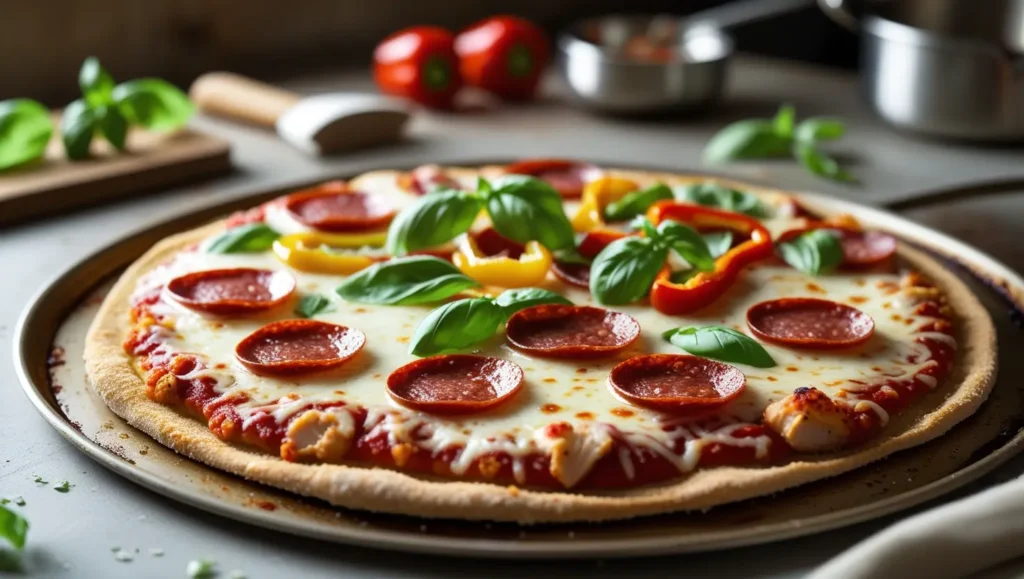
Serving Suggestions and Storage
Chicken crust pizza is best enjoyed fresh from the oven when the crust is at its crispiest and the cheese is perfectly melted. However, with proper handling and storage techniques, you can enjoy leftovers or even prepare components ahead of time for quick weeknight meals.
For immediate serving, let the pizza rest for 3-5 minutes after removing from the oven. This brief cooling period allows the cheese to set slightly, making slicing much cleaner and easier. Use a pizza wheel or sharp chef’s knife to cut into wedges, and serve on warmed plates to maintain temperature longer.
Leftover chicken crust pizza stores well in the refrigerator for up to 3 days when properly covered. Place slices in an airtight container or wrap tightly in plastic wrap to prevent drying out. For best results when reheating, use a toaster oven or conventional oven at 350°F for 5-8 minutes rather than the microwave, which can make the crust soggy.
The chicken crust can be pre-baked and frozen for up to 2 months, making meal prep incredibly convenient. Wrap the cooled, pre-baked crust tightly in plastic wrap and aluminum foil before freezing. When ready to use, thaw in the refrigerator overnight, then add toppings and bake as directed, adding an extra 2-3 minutes to the final baking time.
For meal prep enthusiasts, consider making multiple crusts at once during weekend prep sessions. The time investment is minimal when making several at once, and having pre-made crusts available makes weeknight dinners quick and easy.
Pairing chicken crust pizza with a fresh salad creates a well-balanced meal that satisfies both nutritional needs and comfort food cravings. A simple mixed green salad with olive oil and vinegar dressing complements the rich, savory flavors of the pizza while adding fiber and additional nutrients.
Conclusion
Chicken crust pizza represents the perfect marriage of health consciousness and comfort food satisfaction. This innovative recipe proves that eating well doesn’t require sacrificing the foods you love – it just requires a little creativity and willingness to try something new. The simplicity of preparation, combined with the impressive nutritional profile and genuinely delicious results, makes this a recipe that deserves a permanent place in your meal rotation.
Whether you’re committed to a specific dietary lifestyle, dealing with food sensitivities, or simply looking for ways to increase your protein intake while reducing carbs, chicken crust pizza delivers on all fronts. The versatility allows for endless customization, ensuring you’ll never get bored with this healthy alternative.
The technique is forgiving enough for beginners while offering plenty of room for experienced cooks to experiment with flavors and presentations. Most importantly, the results are satisfying enough that you won’t feel like you’re eating “diet food” – you’ll simply be enjoying delicious pizza that happens to be incredibly good for you.
Take the leap and try this recipe tonight. Start with the basic version to master the technique, then let your creativity run wild with different toppings and flavor combinations. Your taste buds and your health will thank you for making this simple but transformative change to your pizza routine.
FAQ Section
What is chicken crust pizza made of?
Chicken crust pizza is made primarily from ground chicken, cheese (typically mozzarella and Parmesan), and egg, creating a firm and tasty base without flour or traditional dough. The chicken serves as the main structural component, while the cheese provides binding and flavor, and the egg acts as a binding agent to hold everything together during baking.
Is chicken crust pizza keto-friendly?
Yes! This chicken crust pizza recipe is perfectly keto-friendly, containing less than 3 grams of carbs per slice compared to 25-35 grams in traditional pizza. The high protein and moderate fat content align perfectly with ketogenic macronutrient requirements, making it an ideal choice for anyone following a keto or low-carb lifestyle.
Can I make chicken crust pizza without cheese?
While cheese helps bind the crust and provides structure, you can make chicken crust pizza without it, though the texture may not be as cohesive. Try using two eggs instead of one for better binding, or consider dairy-free cheese alternatives if you’re avoiding dairy rather than cheese entirely. The crust may require slightly longer pre-baking to achieve proper firmness.
How do I get a crispy chicken crust?
Achieving a crispy chicken crust requires removing excess moisture from the chicken before mixing and ensuring proper pre-baking. Pat the ground chicken dry with paper towels, use the right oven temperature (425°F), and bake the crust for the full 20-25 minutes before adding toppings. Using parchment paper and avoiding overloading with wet toppings also helps maintain crispiness.
Can I freeze chicken crust pizza?
Yes! You can freeze both pre-baked crusts and fully assembled pizzas. For best results, pre-bake the crust completely, cool it thoroughly, then wrap tightly in plastic wrap and aluminum foil before freezing for up to 2 months. Thaw overnight in the refrigerator before adding toppings and final baking. Fully assembled pizzas can be frozen but may have slightly compromised texture upon reheating.
Have you tried one of our recipes?
There are no reviews yet. Be the first one to write one.
